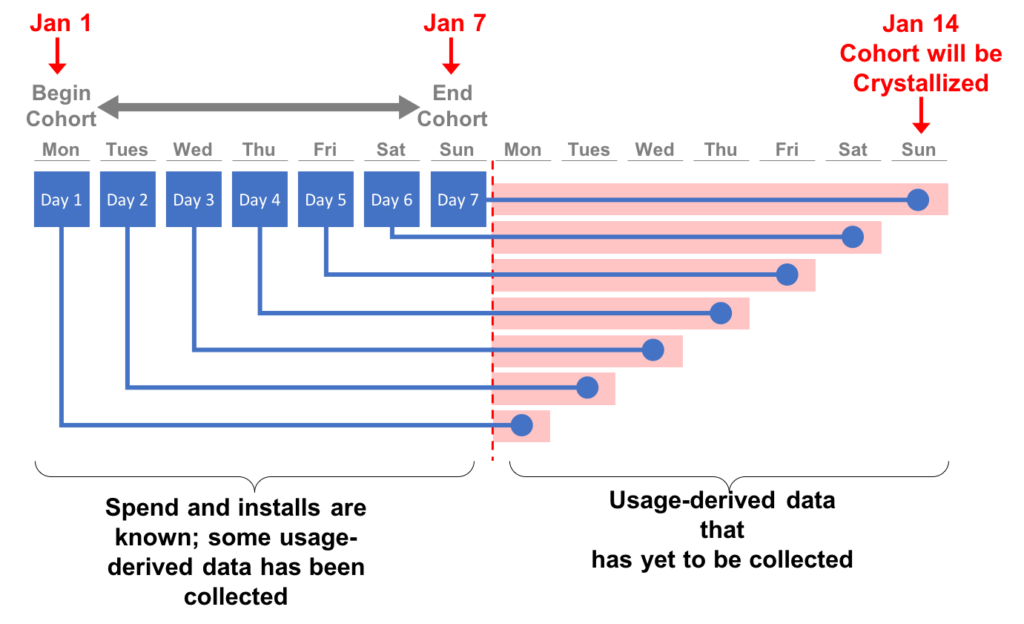Incipia blog
What is Cohort Reporting Crystallization?
Investment bankers and performance marketers are more similar than one might think at first glance.
In both industries the best bankers and marketers are highly competitive, numerate, and analytical. Whether it’s ROI for bankers or ROAS for marketers, they’re equally concerned with making the best use of cash to drive the highest possible returns.
With so many parallels in terms of mindset and the nature of the work, using the same terminology to describe similar phenomenon is helpful for achieving clarity on what can otherwise be tough concepts to explain.
The term ‘crystallization’ is one such financial term that can be applied to performance marketing.1
Definition
Transitive Verb: to cause to take a definite form2
In performance marketing we can deploy the term crystallization to help us describe the exact moment a cohort can be reported on – that is, both fixed metrics such as spend or installs and dynamic metrics, which are usage-based such as ROAS that carry on well after the cohort ends.
In talking to clients or even other marketers it’s commonly misunderstood that the moment a cohort closes we can then know these dynamic metrics for a cohort. Although the cohort may have just closed, it has not yet crystallized.
To understand why, try the example illustrated in the diagram below:
On Monday, January 1st the weekly cohort begins and over the next seven days money is spent to acquire users. At midnight the following Sunday, January 7th, the cohort ends and instantly, many fixed metrics such as the spend and the number of installs become definite – try as we might, we can’t change the amount spent on ads, the number of installs, or quality of the users acquired.
On January 8th – the day after the cohort ends – things get a bit tricky when reporting on those dynamic, usage-based metrics such as retention rate or ROAS. Although there would be a week’s worth of revenue data that had trickled in from all of the users acquired during the cohort period we must wait until the cohort fully crystallizes on the 14th before realizing a fully defined picture of how the campaigns performed in comparison to other cohorts.
By this point all of the users acquired on the 7th will have had a full seven days to generate measurable activity of their own (represented by the red-shaded area in the diagram).
If we reported ROAS, Retention, or other usage-based metrics on January 8th or any of the following days before the cohort crystallized we would theoretically be leaving up to 50% of the data unreported, and thus causing confusion if we attempted to compare this number with crystallized Week0 ROAS metrics from past cohorts.
Put this learning into practice in your campaign reporting by updating the prior week cohort’s revenue/ROAS in the following week when the cohort is crystallized, and only compare metrics from fully crystallized weeks.
1 For those interested in reading more about how the financial industry uses crystallization please see here:
https://www.investopedia.com/terms/c/crystallization.asp
2 However, the term isn't exclusive to finance; it's definition is quite broad:
https://www.merriam-webster.com/dictionary/crystallize
Categories
Tags:
- A/B testing
- adjust
- advertising
- adwords
- agile
- analytics
- android development
- app analytics
- app annie
- app development
- app marketing
- app promotion
- app review
- app store
- app store algorithm update
- app store optimization
- app store search ads
- appboy
- apple
- apple search ads
- appsee
- appsflyer
- apptamin
- apptweak
- aso
- aso tools
- attribution
- client management
- coming soon
- design
- development
- facebook ads
- firebase
- google play
- google play algorithm update
- google play aso
- google play console
- google play optimization
- google play store
- google play store aso
- google play store optimization
- google uac
- google universal campaigns
- idfa
- ios
- ios 11
- ios 11 aso
- ios 14
- ios development
- iot
- itunes connect
- limit ad tracking
- ltv
- mobiel marketing
- mobile action
- mobile analytics
- mobile marketing
- monetization
- mvp
- play store
- promoted iap
- promoted in app purchases
- push notifications
- SDKs
- search ads
- SEO
- skadnetwork
- splitmetrics
- startups
- swift
- tiktok
- uac
- universal app campaigns
- universal campaigns
- user retention
- ux
- ux design
